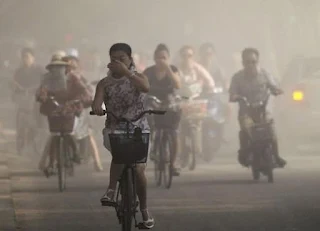Many people in the world, including Indonesia, do not care about air pollution caused by exhaust gases from factories and motor vehicles. Especially in big cities are increasingly crowded by motorized vehicles.
Not infrequently the owners of motorized vehicles, both public and private vehicles, do not care about their exhaust emissions. As a result, motorized vehicles contribute 70% of polluting materials to the air.
Well, have you ever thought about the impact of this air pollution on human health? Just imagine how much air pollution is inhaled by pedestrians. Have you ever tried to walk outside in a closed vehicle and felt breathless?
Yes, indeed air pollution can have an impact on the respiratory system. For some people, the effect is not immediately felt. However, these residues will continue to accumulate and cause respiratory disease. Motor vehicle exhaust contains various organic and inorganic compounds. These compounds can enter through the nose when breathing.
Characteristics and Composition of Vehicle Emissions
As previously mentioned, the gas emitted by motorized vehicles consists of various compounds. Factors that affect the composition of the content of this compound include emission control devices, engine type, driving conditions, operating temperature and others. The smoke that comes out of the exhaust on a vehicle that uses diesel is clearly visible, in contrast to a vehicle that uses gasoline, whose gas output does not appear to be billowing black.
Actually, the main compounds of motor vehicle emissions are harmless, namely in the form of carbon dioxide, nitrogen, and water vapor. However, there are also other compounds that are very harmful to the environment and health.
The composition of these compounds is quite large. These harmful compounds are carbon monoxide, various nitrogen oxide compounds, various hydrocarbon compounds, sulfur, and dust particles including lead.
Evaporation from the fuel system will release organic lead and hydrocarbons into the air. In the air there will be a variety of reactions, some fast and some long and complicated. The product of the reaction can be a product that is weaker or more active than the starting compound.
The more reactive nitrogen dioxide can be produced from the reaction of nitrogen monoxide in the air. Hydrocarbon compounds with nitrogen oxides can form ozone along with other oxides, resulting in photochemical smog or smog. This smog actually often occurs on the outskirts of the city, the distance depends on the wind speed and reaction conditions.
Other pollutants even though they are more stable in nature can still contaminate water and soil by settling with dust or falling with rainwater to the ground. Some of these compounds include halogen hydrocarbons, polyaromatic hydrocarbons, and lead.
The compounds that have contaminated the water and soil can enter the human body through the products of livestock and vegetables that are consumed. This is because these compounds enter vegetables and animals through the food chain cycle. Motor vehicle exhaust compounds can also cause acidic water and soil conditions. This causes metals and minerals in the soil bond to be released and pollute the environment.
Impact of Emissions on Health
Motor vehicle emissions are more dangerous than power plants and industry because the combustion products have a higher pollutant content. Moreover, this is in the midst of society and can be easily inhaled. In contrast to the factory which has a gas chimney with a high position.
Compounds enter the human body not only through the air inhaled by breathing. But also through snacks that are exposed to pollutants on the roadside. The level of compounds attached to this food of course depends on the traffic conditions on the road.
Some of the health problems that can be caused by motor vehicle pollution are lung cancer and other organ cancers, disorders of the throat, both acute and chronic, damage to the nervous system and even death. It also depends on exposure to these harmful compounds in humans and how long a person has been exposed to, as well as the age of the humans exposed.
The elderly and children have a higher risk of exposure to this pollution. Lung function and the ability to adjust lung capacity in the elderly tend to decline, as well as their immunity. Children have different lung functions again, they are more sensitive to respiratory infections. Groups that are also sensitive to air pollution are people with lung and heart disease because their lung capacity is low.
The following is a classification of the effects of harmful compounds from vehicle emissions based on their impact on human health:
1. Respiratory disorders
In this category, these hazardous compounds are oxides of nitrogen, sulfur oxides, ozone, particulates and other types of oxides. The organs in the respiratory tract have a direct influence because they are in direct contact with these toxic compounds when air is inhaled by the nose. These compounds cause irritation and inflammation in the respiratory system.
Sulfur and particulate oxides have a synergistic character that has the potential to increase the risk to human health. The oxide of nitrogen in the form of nitrogen dioxide is a very toxic gas. This gas is able to penetrate deeper into the respiratory system. First, this gas will affect lung tissue and mucous membranes. In addition, nitrogen dioxide can also enter the bloodstream from the lungs.
2. Systemic toxic effects
These compounds include monoxide and lead hydrocarbons. When the compound is absorbed by the lungs, it will be carried to other parts of the body through the blood circulation and lymph fluid. This of course will harm the organs contained in the body.
In addition to the lungs, compounds that enter through the nose and are in the bronchial mucosa are swallowed and enter through the esophagus or are carried by the blood circulation. Then the digestive tract absorbs these compounds.
3. Cancer
Compounds that have the potential to cause this impact are hydrocarbons. The very small size of gases and particulates of these gases and particulates can be less than 2 micrometers. Their properties are mutagenic and carcinogenic. Carcinogenic compounds have the potential to cause tumors in organs other than the lungs.
Impact of Emissions on the Environment
Apart from having a direct impact on human health, what are the impacts of motor vehicle emissions on the environment? Some of the non-toxic compounds contained in motor vehicle exhaust are still harmful to the environment. Carbon dioxide is harmless to human health. However, the impact of carbon dioxide on the environment can lead to the greenhouse effect.
The presence of these gases in the atmosphere will absorb heat and inhibit the heat from going to a higher layer of air, resulting in an increase in the average temperature of the earth's surface. So, the icebergs will melt and raise sea levels. Of course this will disrupt the natural cycle.
Another gas that affects the environment is sulfur dioxide. This substance will cause red brown spots or white spots on the leaf surface. In addition, the gas also causes damage to buildings. The presence of sulfuric acid and sulfuric acid causes acidity in rainwater so that it can cause rust on metal. Meanwhile, nitrogen oxides play an important role in the formation of smog.


